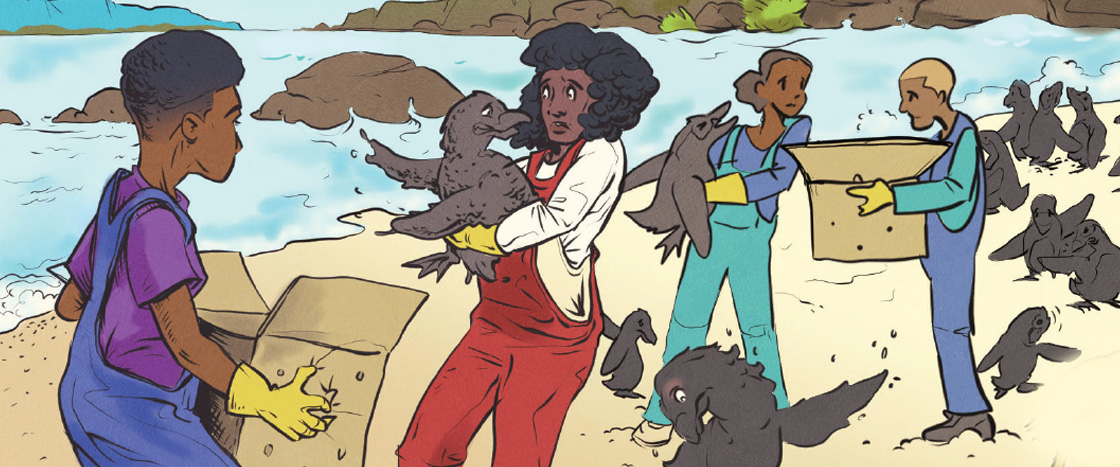"I can’t eat another bite! Time to head home."

An Amazing Penguin Rescue
When a massive oil spill threatens thousands of penguins, can scientists and volunteers save them?
Learning Objective: Students will explain how humans rescued thousands of penguins endangered by an oil spill.
The year 2000, the Atlantic Ocean, off the coast of Robben Island in South Africa
"Wait, what’s wrong with the water? It’s too thick. It’s burning my eyes!"
"Why am I so c-c-cold? My feathers feel sticky and wrong."
"I can’t get this gunk off me! What’s going on?"
"I can answer that! Hi, I’m Dyan deNapoli. I work at the New England Aquarium."
About 1,300 tons of oil spilled from a sinking ship. It spread to Robben Island, the habitat of about 20,000 African penguins. This thick substance is poisonous.
The oil coated the penguins’ feathers. They couldn’t swim or keep warm. Swallowing the oil made them sick. As a scientist, I was asked to help save them. But I wasn’t alone. Thousands of volunteers arrived.
"They’re shivering! They won’t survive like this. We have to clean the oil off."
"What a mess! There's oil everywhere. . ."
We collected the penguins and transported them to a warehouse. There, we could keep them fed and warm until they could be cleaned.
"Where are we going?"
"Ugh, it smells like fish and bird poop in here!"
"At least the penguins are safe now."
It took two people to clean each penguin.
"I’ll hold him, and you spray the degreaser."
"This will break down the oil."
"I’ll give him a good scrub with warm, soapy water until he’s clean."
"The area near his eyes is delicate."
"Don't be scared. I won’t hurt you."
The whole process took an hour for each bird.
"That feels so much better!"
"A final rinse with water and we’re done!"
Even with 12,500 volunteers working hard, it took a month to bathe them all!
"What happens now?"
But there was another problem. The ocean current was spreading the oil north, toward Dassen Island. Now 20,000 more African penguins were in danger.
"We don’t have enough supplies to save that many more birds."
"What if we move them down the coast? By the time they swim home, the oil will have moved away!"
Nothing like it had ever been done before . . .
But we had to try. We moved the Dassen Island penguins 500 miles away to a city then known as Port Elizabeth. It took two weeks for them to swim home. When they arrived, the oil was no longer there. The water was safe and clean. The plan worked!
After currents swept the oil away, Robben Island was also safe again. The rescuers returned the 20,000 cleaned penguins to their home.
"We saved more than 40,000 penguins!"
"We can check up on them later."
It was the largest penguin rescue in history! The penguins could go back to their lives, oil-free.
"I'm home! It's clean and sparkling."
"Just like it should be."
1. PREPARE TO READ (10 minutes)
Watch a video and discuss penguin traits.
- Tell students they are going to learn about a special kind of bird: penguins! Play the video “World of Penguins.” Ask: What do penguins have in common with other birds? (e.g., feathers, beaks) What makes penguins unusual birds? (They don’t fly.) Since they don’t use feathers to fly, how do feathers help penguins? (Feathers keep penguins warm.)
- Invite students to mimic the penguin movements they see in the video, reminding them to be respectful of others’ space and responsible while they move. Ask: Why do you think penguins have different ways of moving? (They spend time in the water and on land.) Tell students that sometimes oil spills happen in penguins’ habitats, or where they live. Ask students: How do you think an oil spill could affect penguins? Discuss.
2. READ AND SUMMARIZE (20 minutes)
Read the article and explain the scientists’ problem-solving steps.
- Tell students they are going to learn about one such oil spill. Read the article aloud or play the video read-aloud.
- Distribute the Problem Solvers activity. Discuss the problem and solution described in the first row. Then ask: What was the second problem the volunteers and scientists faced? (Penguins couldn’t remove oil from their own feathers.) What solution did the volunteers come up with? (They cleaned the penguins thoroughly.) Have students complete the remainder of the activity in pairs. Reconvene as a class and discuss the concluding question.
2. RESPOND TO READING (30 minutes)
Carry out a hands-on investigation exploring how oil affects feathers and how to remove it.
